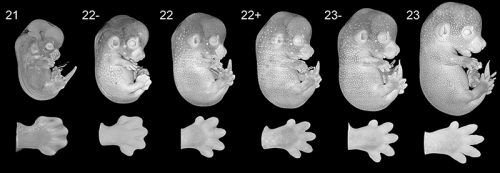Why are geneticists measuring the webbing between mouse embryo fingers?
Posted by DMDD, on 21 February 2017
A new paper published in Journal of Anatomy shows that measuring the amount of inter-digital webbing in mouse embryos between 14 and 15 days gestation is the best way to find out their exact stage of development.
So why is this important to a geneticist? If we want to discover a causal link between a gene mutation and a developmental abnormality in a mouse, we need to be really sure that any abnormalities we see aren’t just standard features of embryo development. The morphology of an embryo can change rapidly as it grows, and things that seem unusual at first glance might be completely typical for a given stage of development. Understanding and avoiding these potential pitfalls is hugely important when studying embryos for the effects of a gene mutation.
Using the new technique described by the authors, it’s now possible to find an embryo’s exact developmental stage simply by looking at its fingers.
NORMAL OR ABNORMAL?
To be sure that an embryo has developed abnormally, we need to compare it to one that we know has developed normally. But this can be a complicated comparison to make when an embryo’s ‘normal’ appearance is changing dramatically as it develops.
Cleft palate is a serious abnormality, as it can prevent a mouse pup from suckling and eventually lead to death. But the palate is also one of many tissues that changes its structure and orientation dramatically between E14 and E15 (days 14 and 15 of gestation). The image below shows three snapshots of a typical mouse embryo palate during this period.

Not only do the palatine plates completely change their orientation, they also move one at a time. Without knowing the precise developmental stage of an embryo, it would be impossible to tell whether the palate was developing normally, or whether a cleft palate had developed as a resust of a gene mutation.
Dramatic changes within a similarly short timeframe can also be seen in both the heart and the intestine. It’s vital to measure the developmental stage of the embryo as precisely as possible, so that it can be compared to what is normal at that exact stage.
MEASURING INTER-DIGITAL WEBBING
In the past, the development of a mouse embryo has been described using a set of 26 Theiler stages. Days 14 – 15 of gestation are typically described by the stages 21, 22 and 23.
However, the authors found that for embryos of this age many organs and tissues developed rapidly even within a single Theiler stage. The stages weren’t granular enough to be sure that tissues like the palate, heart and intestines were really showing abnormal development. To address this the article defines 6 alternative stages, together with a novel technique to identify the stage solely by measuring the amount of webbing between the embryo’s fingers.

During this time, the forelimb develops from a paddle to a hand with separate fingers. The full set of new stages S21, S22-, S22, S22+, S23- and S23 allow the developmental stage of the embryo to be determined much more precisely, meaning that developmental abnormalities can be identified with confidence.
This article was originally posted on the DMDD blog and is based on the original article SH Geyer et al., ‘A staging system for correct phenotype interpretation of mouse embryos harvested on embryonic day 14 (E14.5)‘, J. Anat., doi:10.1111/joa.12590.


 (No Ratings Yet)
(No Ratings Yet)